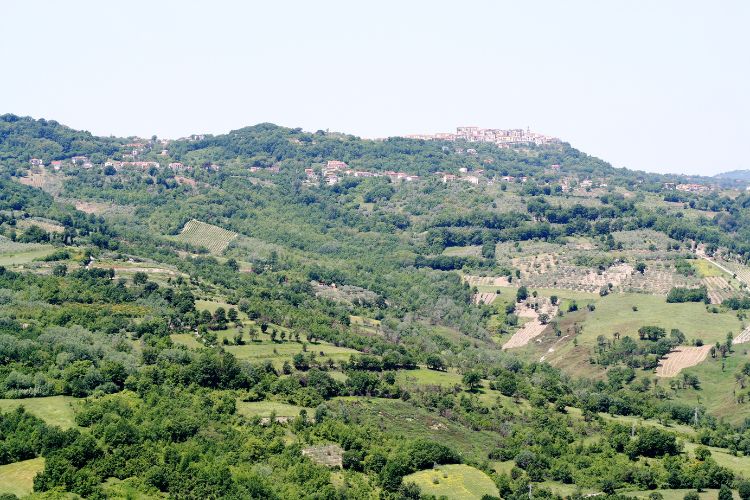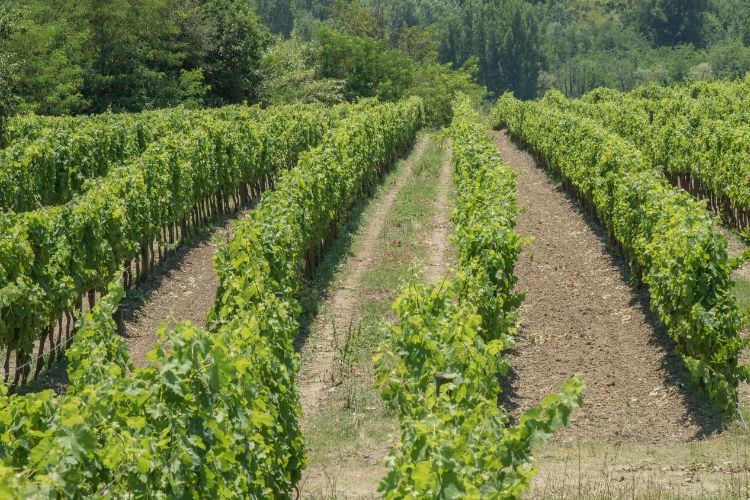Fall in Love with Aglianico
Last Updated on October 5, 2023.
Aglianico is a black and blue grape variety that produces predominantly dry red wine. It is thought to be of Phoenician origin. This wine was prized and distributed by the Greeks throughout their ancient trade routes, and thoroughly enjoyed by ancient Roman culture as well.
Today, Aglianico has for the most part disappeared from the Greek islands. It is now most well known for being grown in the Campania region of Southern Italy, especially in the Taurasi DOCG. The Campania area also encompasses both beautiful Naples, Amalfi and Salerno.
IN THIS GUIDE:
- Taste
- Pairings
- Terroir
- Aging
- Wine Recommendations
- …and more
What Does Aglianico Wine Taste Like?
The traditional tasting notes of Aglianico have both depth and complexity. This is a somewhat obscure wine grape that very much deserves more attention for its flavor profile.
Aglianico fruit notes are plum, red cherry, and fig with notes of red and black pepper, cacao, mushroom, and sometimes brightness of tomato. There can also be limestone minerality running through.
Aglianico Food Pairings
Because Aglianico produces fuller-bodied red wines with deep tannin structure, consider rich and savory meats. It’s ideal to pair with grilled steak, lamb, roasted pork or braised barbecue ribs.
Older Aglianico will pair better with sweet and savory foods, while younger wines are better paired with both spicier dishes. Most Mexican and Indian plates work well with younger Aglianico (good luck finding it in a Mexican or Indian restaurant but consider buying a bottle and making a dish at home — you won’t regret it).
Climate and Terroir for Aglianico

While the Old World is still the most famous for producing Aglianico, New World Vintners are now making concerted efforts to harness its awesome flavor. Duchman Family Winery in Driftwood, Texas produces a delicious Aglianico. The limestone soil composition, compounded with both the dry and very sunny climate in Driftwood is reminiscent of the terroir in parts of Southern Italy, thus making it an ideal location for new world Aglianico vine growth.
These grape vines tend to grow best in dry and well-aerated soil. They love lots of sunshine and tend to bud early while ripening late. Even though the skins of Aglianico pack large amounts of polyphenols (making them heavily tannic), they are surprisingly susceptible to a couple of diseases, particularly noble rot. Thus, it’s imperative that vines are micromanaged, not overly saturated, and harvested on time.
How is Aglianico Aged?
It’s a grape variety that most commonly yields full-bodied, dry red wines. Good wines tend to be refreshingly acidic with gritty tannins and red fruit. This structural composition actually makes it an ideal style for long-term aging.
These wines should be aged for at least a couple of years before consumption, and in Taurasi, there’s actually a 3-year requirement (with one being in oak). Reserve variations of Taurasi reds require at least 4 years of aging and can also be blended with other well-known Italian varieties, including Barbera and Sangiovese.
While New World variations are less regulated and can be consumed while young, the red fruit notes become more rounded with the and tannic structure mellowing out over time. Aged Aglianico is typically more balanced and approachable.
Growing & Harvesting Aglianico

When it comes to cultivating Aglianico grapes, precision and expertise are paramount. One of the first considerations is the trellising system. Given that Aglianico vines tend to bud early and ripen late, a well-designed trellis system is crucial for maximizing sun exposure and air circulation. The Guyot and Spur Cordon systems are often employed to achieve this balance. These systems not only support the vines but also facilitate easier pruning and harvesting.
Speaking of pruning, Aglianico vines require meticulous attention. Pruning is generally conducted during the dormant winter months, and it’s a critical step to control yield and concentrate flavors. Overcrowding can lead to grapes that lack intensity, so careful pruning ensures that each cluster gets the nutrients and sunlight it needs.
Soil management is another critical aspect of Aglianico viticulture. The grape thrives in well-drained, volcanic soils rich in minerals. These conditions are naturally found in its traditional growing regions in Southern Italy, particularly in Campania and Basilicata. However, the grape’s adaptability has allowed it to flourish in other regions with similar soil compositions, such as certain parts of Texas. Irrigation is generally kept to a minimum to stress the vines slightly, encouraging them to root deeper into the soil for nutrients. This practice enhances the grape’s natural flavors and complexities.
Timing the harvest is the final, yet perhaps most crucial, aspect of Aglianico cultivation. Due to its late ripening nature, Aglianico is often one of the last grape varieties to be harvested, sometimes as late as November. This extended growing season allows for a full development of flavors and tannins, but it also increases the risk of exposure to diseases like noble rot. Therefore, vineyard managers must keep a vigilant eye on weather conditions and disease indicators to choose the optimal harvest time. When done correctly, the result is a grape that is rich in flavor, high in tannins, and perfectly suited for long-term aging, making all the meticulous viticulture practices well worth the effort.
Wines Regions That Produce Aglianico
Aglianico’s historic heartland lies in Southern Italy, particularly in the regions of Campania and Basilicata. Within Campania, the Taurasi DOCG stands out as a premier growing area, often referred to as the “Barolo of the South” due to the high quality of its Aglianico wines. Basilicata’s Aglianico del Vulture is another noteworthy appellation, where the volcanic soils lend the wines a unique mineral complexity. These Italian regions have been the grape’s stronghold for centuries, and the wines produced here are often considered the benchmark for Aglianico’s potential. They typically showcase the grape’s full-bodied nature, high acidity, and robust tannic structure, making them ideal candidates for aging.
However, the allure of Aglianico has crossed oceans, finding a home in New World wine regions as well. In the United States, Texas has emerged as a surprising yet promising area for Aglianico cultivation. The Texan terroir, particularly in areas like the Hill Country, share similarities with Southern Italy, including limestone-rich soils and a warm, dry climate. These conditions have allowed Texan winemakers to produce Aglianico wines that are both expressive and complex. Similarly, California’s Paso Robles region has also dabbled in Aglianico, taking advantage of its Mediterranean-like climate to produce wines that are fruit-forward yet balanced by the grape’s natural acidity and tannins.
Aglianico Wines Are Historically Significant
Originating from the Phoenicians, this grape variety was later cultivated and popularized by the Greeks. However, it was during the Roman era that Aglianico truly flourished. The Romans were not just casual drinkers; they were connoisseurs who understood the value of a good wine. Aglianico was often used in Roman ceremonies and religious rites, signifying its elevated status in society. It was also a staple in Roman banquets and was likely consumed by senators and emperors alike. Some historical records even suggest that Aglianico wines were used as a form of currency in trade, underscoring its economic importance.
The Roman influence didn’t stop at the Italian peninsula; Aglianico was distributed throughout the expansive Roman Empire, from the Iberian Peninsula to the far reaches of Northern Africa. This widespread distribution helped cement Aglianico’s reputation as a wine of significance and quality. It’s worth noting that the Roman army also played a role in its proliferation. Aglianico wines were often included in military rations, believed to fortify soldiers and boost morale during long campaigns. This military angle adds another layer to the grape’s historical narrative, illustrating its versatility and widespread appeal.
Fast forward to the modern era, and Aglianico has become somewhat of a hidden gem, especially when compared to more globally recognized Italian varieties like Sangiovese or Nebbiolo. However, its historical significance is seeing a resurgence among wine enthusiasts who appreciate both the rich flavors and the rich history that come with each bottle.
Try some of these Aglianico wine recommendations from around the world:
- Elena Fucci, Aglianci del Vulture Titolo, Basilicata, Italy
- Feudi di San Gregorio, Agliantico Rubrato, Campania, Italy
- Mastroberardino, Radici Taurasi, Campagnia, Italy
- Ryme, Luna Matta Vineyard, Paso Robles, Central Coast, California
- Giornata, Luna Matta Vineyard, Paso Robles, Central Coast, California
Learn About These Other Wine Grape Varieties
Written By Jamie Metzgar
Jamie Elizabeth Metzgar began her career in wine by pouring in a tasting room on the East End of Long Island, NY. After moving to New York City, she landed a position at Chambers Street Wines where she was encouraged to pursue wine education at the Wine & Spirits Education Trust (WSET). She earned Level III certification there and has since earned California Wine Appellation Specialist and Certified Specialist of Wine certifications as well. After way too many moves, she has recently landed in Northern California where she is compiling an unofficial roster of dog-friendly tasting rooms.
Aglianico Wine & Grape Variety Characteristics
Common Flavors and Aromas
- Fruit: Red
- Earth & Mineral Notes: Limestone, Dust
- Additional Complexities: Chocolate, Tomato, Mushroom, Red Pepper, Cacao
Aglianico Wine Structural Composition
Aglianico or Taurasi wines are typically full-bodied, highly tannic with elevated acidity.
Body Full
Sugar Dry
Tannins High
Acid High
Alcohol High (13.0%-14.5% ABV)
Finish Medium-Long
Grilled Meats
Being a big-bodied red wine with a deep tannin structure, consider rich and savory meats. Ideal to pair with grilled steak, lamb, roasted pork or braised barbecue ribs.
Sweet & Savory Foods (IE: Mexican, Indian Dishes)
Remember, older Aglianico will pair better with sweet and savory foods, while younger wines are better paired with both spicier dishes. I tend to enjoy most Mexican and Indian plates with younger Aglianico (good luck finding it in a Mexican or Indian restaurant, but consider buying a bottle and making a dish at home -- you won't regret it).